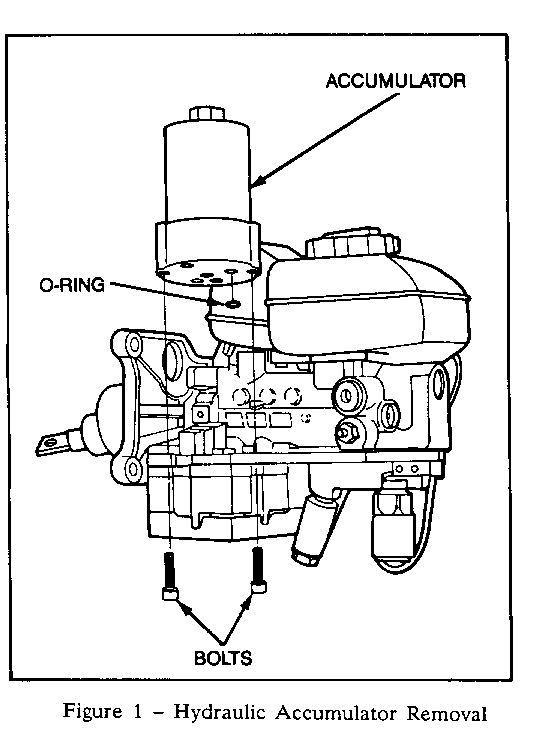BOSCH ANTI-LOCK BRAKE SYSTEM ACCUMULATOR SERVICE-NEW P/N

VEHICLES AFFECTED: 1987 -1989 ALLANTE
This bulletin pertains to some 1987-1989 Allantes equipped with Bosch Anti-Lock Brake System and the hydraulic accumulator which is an integral part of the hydraulic unit. The hydraulic accumulator was previously considered non-serviceable and the accumulator was repaired by replacing the entire hydraulic unit.
This bulletin outlines the procedure to service the hydraulic accumulator without replacing the entire hydraulic unit. Accumulator service kits are available using part number 3520224.
CAUTION:
Some operations in this bulletin require that hydraulic lines, hose and fittings be disconnected for hydraulic accumulator service. This brake system uses a hydraulic accumulator which, when fully charged, contains brake fluid at high pressure. Before disconnecting any hydraulic lines, hoses or fittings, be sure that the accumulator is fully depressurized as described in this step 1 of the service procedure in this bulletin. Failure to depressurize the hydraulic accumulator may result in personal injury and/or damage to painted surface.
SERVICE PROCEDURE
Hydraulic Unit Removal:
1. The following procedure should be used to depressurize the hydraulic accumulator.
With ignition off, pressure switch disconnected, pump motor connector disconnected, or negative battery cable disconnected, pump the brake pedal a minimum of 25 times using approximately 50 lb. (222 N) pedal force. A noticeable change in pedal feel will occur when the accumulator is discharged.
When a definite change in pedal effort is felt, stroke pedal a few additional times, this will remove all hydraulic pressure from the system.
2. Consult Section 5E in Service Information Manual for disconnect and removal of the hydraulic unit.
Accumulator Removal:
1. Place hydraulic unit on bench to access bottom of hydraulic accumulator.
2. Remove both torque screws which hold the accumulator to the hydraulic unit, refer to Figure 1.
3. Remove the hydraulic accumulator and 0-ring seal.
CAUTION:
Do not unscrew top of accumulator from its base. The hydraulic accumulator is only serviceable by removing both screws located on the bottom of the accumulator.
Accumulator Installation:
1. The hydraulic accumulator kit (P/N 3520224) contains: hydraulic accumulator (1), 0-ring seal (1), torx screws (2).
IMPORTANT: Use all of the parts included in the hydraulic accumulator kit. Discard the old accumulator, 0-ring and screws.
2. Lubricate the 0-ring seal with clean brake fluid and install into hydraulic unit.
3. Make sure the mating surfaces are clean and free from any dirt.
4. Place the hydraulic accumulator onto the hydraulic unit and ensure for correct fit using the locating tabs.
IMPORTANT: Make sure 0-ring seal is in place and no damage has occurred during installation of the hydraulic accumulator.
5. Torque screws to 4-5 ft. lbs. (5-7 N-m)
6. Alter the screws have been torqued, tighten on additional 90 degrees.
Hydraulic Unit Installation:
1. Consult Section 5E for connection and installation of the hydraulic unit.

General Motors bulletins are intended for use by professional technicians, not a "do-it-yourselfer". They are written to inform those technicians of conditions that may occur on some vehicles, or to provide information that could assist in the proper service of a vehicle. Properly trained technicians have the equipment, tools, safety instructions and know-how to do a job properly and safely. If a condition is described, do not assume that the bulletin applies to your vehicle, or that your vehicle will have that condition. See a General Motors dealer servicing your brand of General Motors vehicle for information on whether your vehicle may benefit from the information.
